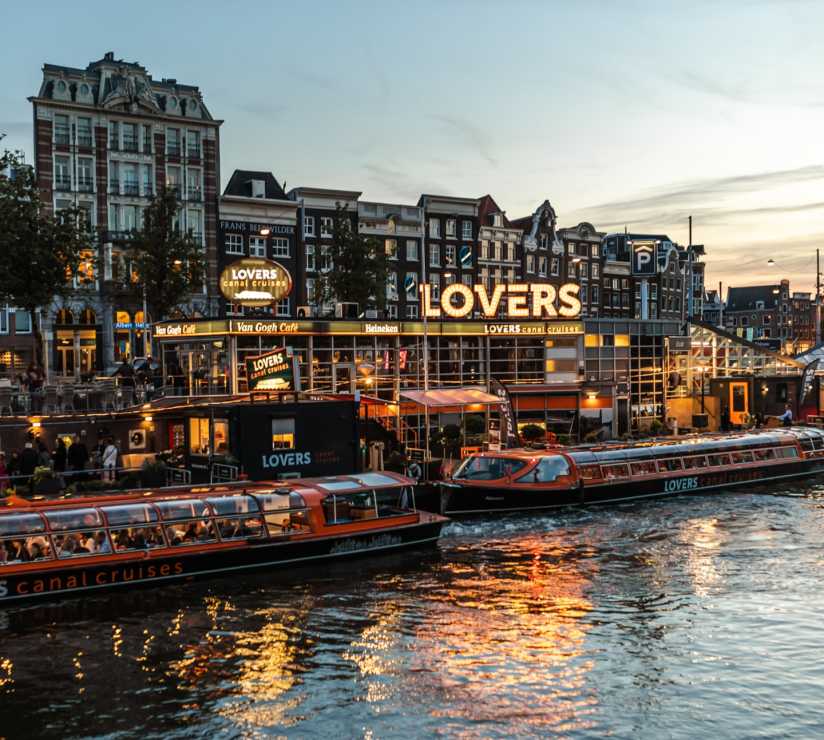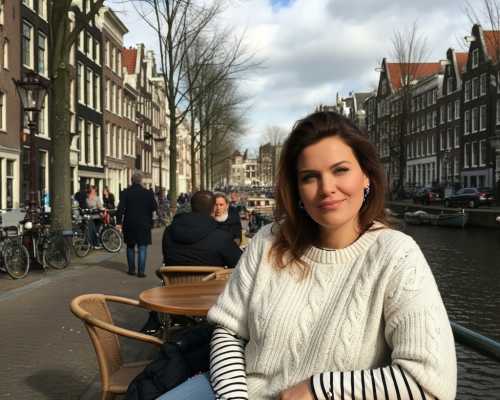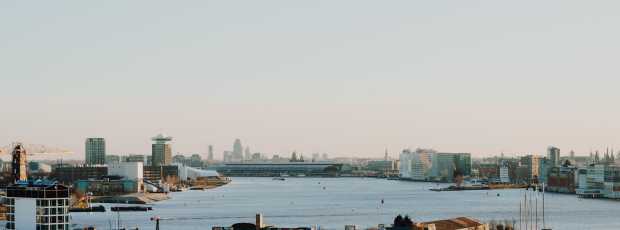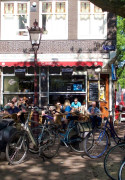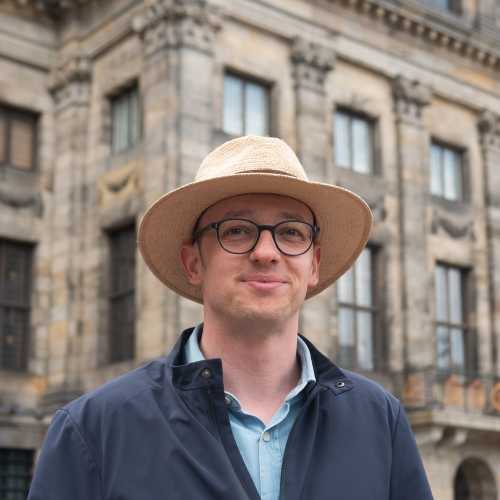Very nice tour with our guide Anna, who was always very attentive, kind, and responsive to our wishes. I highly recommend this activity!Nicolas, Amsterdam, 2025
Table Of Contents
- Why Trust a Local for the Best Things to Do in Amsterdam?
- Must-Sees for an Amazing Time in Amsterdam
- Overrated Spots: Keep, Tweak, or Alternative
- Hidden Gems: The Amsterdam Locals Enjoy
- Neighborhood Guide: Where to Wander
- Authentic Eats: Traditional Dutch Foods That Taste Amazing
- Cultural Experiences That Matter
- Practical Stuff That Actually Helps
- Frequently Asked Questions
- My Honest Take After Fifteen Years

Amsterdam canal at golden hour with bikes lined along the bridge
I've lived in Amsterdam for over a decade, and I've watched countless visitors fall into the same traps.
They line for hours at overcrowded attractions, take those awful glass boat canal cruises, and think they've experienced the real city.
As someone who explores with City Unscripted guests regularly, I see this disconnect way too often.
I'm Maartje van Dijk and I want to show you the Amsterdam experiences that locals love.
The one where you can still find quiet courtyards in the Jordaan, where the best museums have strategies that skip the worst crowds, and where a perfect afternoon involves a free ferry ride and a brown café that's been serving the same families for generations.
I won't go on about hidden gems that aren't truly secret or pretend tourists ruin everything.
Instead, I want to show you that doing the classic things smartly and discovering the rhythms that make this city feel like home is how you'll have a memorable visit.

Amsterdam Central Station
Why Trust a Local for the Best Things to Do in Amsterdam?
Because I've made every mistake you're about to make. I've stood in those ridiculous Anne Frank House lines before learning the booking system.
I've taken the wrong canal cruise and paid twice as much for half the charm. I've eaten terrible cheese in tourist shops when the real stuff was three streets over.
When you're hosting visitors every week like I do, you quickly learn what actually works. Which museums reward the effort, which neighborhoods feel authentic without being performative, and how to time your day so you're eating stroopwafels when they're still warm and drinking beer when the locals are just settling in.
The best things to do in Amsterdam aren't necessarily secret. They're just done differently when you know how.
Must-Sees for an Amazing Time in Amsterdam
These experiences define Amsterdam better than any guidebook list. Master these, and you'll understand why locals choose to stay in this small, soggy, expensive city.

Anne Frank House
Anne Frank House: Worth Every Minute
Yes, everyone goes. Yes, you should too.
The Anne Frank House releases tickets exactly six weeks ahead of time, every Tuesday at 10:00 CET. Set three alarms, have your payment info ready, and pray your internet doesn't crash. A limited number of same-day tickets are also released, but those go super quickly.
Even with tickets, arrive early. Your slot gives you a window, not a guarantee of no lines. The museum works best when you can move through the rooms at your own pace, which happens most easily in the first hour of your assigned time slot.
The secret passages and hidden rooms hit differently when you're not being pushed along by crowds. Book ahead of time and arrive early, about 15 minutes before your slot opens.
Winter tip: The museum stays equally powerful year-round, and shorter daylight hours mean fewer competing attractions.
Imagine Experiencing Amsterdam for Real
A local can show you the vibe, flavors, and hidden gems up close.

Van Gogh Museum exterior
Van Gogh Museum: More Than Just Sunflowers
As you may probably guess, the Van Gogh Museum holds the world's largest collection of Vincent van Gogh's work. But most visitors sprint toward the famous sunflowers and miss the progression that makes this place extraordinary.
I suggest you start with the early works on the first floor.
You can watch Vincent van Gogh discover his style in real time, from those dark potato eaters to the explosion of color that happened when he hit Paris.
The building itself, designed by Gerrit Rietveld, gives the artwork room to breathe without competing for attention. In just two years in Paris his palette flipped, which the layout makes obvious.
Go midweek, ideally Wednesday or Thursday mornings. The crowds thin out enough that you can stand in front of paintings without someone's elbow in your ribs. The largest collection of his art deserves more than a rushed photo opportunity.
Price reality: €24 for adults, but worth every euro for the comprehensive collection you won't find anywhere else.
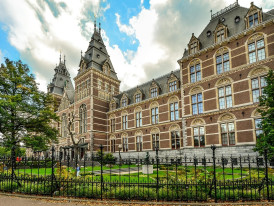
Rijksmuseum Amsterdam
Rijksmuseum: Eight Centuries of Dutch Swagger
The Rijksmuseum is basically the Netherlands showing off 800 years of being pretty damn successful. Head straight to the Gallery of Honour on the second floor for Rembrandt's Night Watch and Vermeer's Milkmaid. It's a crash course in Dutch art and history in one building.
Skip the Asian pavilion unless you have serious time. The Golden Age rooms tell Amsterdam's story better than any history book. These painters captured the city when it was the richest place on earth, and you can see that confidence in every brushstroke.
The museum's free garden behind the building makes a perfect break between art overload sessions. Most tourists never find it, but locals use it as a reset between cultural doses.
Rainy day backup: Perfect weather refuge with café and extensive collections that could fill an entire afternoon.

Glass roof canal boat
When Is a Canal Cruise Actually Worth It?
I used to roll my eyes at canal cruises. Then my sister visited, dragged me onto one, and I had to eat my words.
There's something about seeing Amsterdam from the water that makes you understand why people built a city in this impossible place.
I recommend that you skip the big glass-topped tour boats if you can, the open boats let you actually experience those narrow canals instead of just looking at them through a window.
A canal cruise remains one of the best things to do in Amsterdam for first-time visitors trying to wrap their heads around how this city actually works.
Weather note: Evening cruises work beautifully in rain; you'll see lit windows and cozy interiors instead of facades. Winter cruises offer hot chocolate and fewer crowds.
Begijnhof is one of Amsterdam's oldest surviving spaces and a must-see for all tourists.
Begijnhof: Medieval Courtyard in Plain Sight
This hidden courtyard sits close to Dam Square but most tourists walk right past it. Medieval houses around a grass square where Catholic women lived in religious community for centuries. This is one of Amsterdam's oldest surviving spaces.
Smart approach: Enter through the unmarked door on Spui. Stay quiet, avoid flash photography, and remember people still live here. Best light happens around 4 PM when sun hits the chapel windows.
Free admission and perfect rainy day refuge; the covered walkways provide shelter while you explore medieval Amsterdam.
Brown Cafés Are a Cultural Experience
Brown cafés aren't just bars with old furniture. They're Amsterdam's living rooms, and there's an etiquette that makes them work.
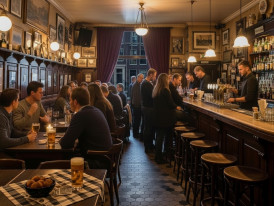
Evening atmosphere in a traditional brown café
Order small beers (250 mL glasses, about 8.5 oz.) because that's how conversations happen here. You're not trying to get drunk quickly; you're settling in for the long game. Good brown cafés have newspapers, board games, and regulars who've been holding down the same corner table for decades.
Café Chris in the Jordaan has been family-run since 1624. Café de Reiger serves better bar snacks than most restaurants. In de Wildeman specializes in Dutch beers you can't find anywhere else.
The ritual matters as much as the beer. Locals arrive after 8 PM and stay until conversation runs out, nursing small glasses and making each beer last an hour.
These spots show you Amsterdam's soul better than any monument.
Don’t Just Visit. Feel Part of It.
Locals share their city as they live it, so even a few hours can feel like you truly belong.
Overrated Spots: Keep, Tweak, or Alternative
Not everything in Amsterdam lives up to its reputation. After fifteen years here, I've got some opinions about the famous spots you can skip without missing out.
Tip: Skip the Script
The Red Light District's history is genuinely fascinating, seeing it for yourself is a unique experience.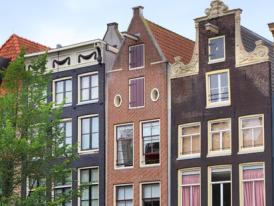
Historic Red Light District architecture during daytime
Red Light District: More Selfie Sticks Than Expected
Look, I get the curiosity about the Red Light District. The history is genuinely fascinating. This area has been dealing with sex work for centuries, and there's something honest about making it visible instead of pretending it doesn't exist.
But here's what actually happens when you stop by: you'll mostly be shuffling through crowds of drunk tourists taking photos and dodging overpriced bars that serve watered-down drinks.
The area draws crowds for photos, but the reality involves navigating drunk tourists and overpriced bars.
- Keep: Visit during daytime hours (10 AM to 4 PM) when you can actually appreciate the historic architecture and beautiful old buildings.
- Tweak: Stop by Red Light Secrets museum for educational context about the neighborhood's history and current regulations.
- Alternative: Take an evening canal walk along Herengracht around 9 PM for magical lighting and atmosphere without the chaos.
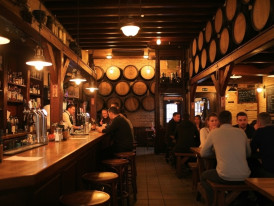
Traditional Amsterdam brown café interior
Tourist Coffee Shops: Highway Robbery with a Side of Regret
The coffee shops clustered around Centraal Station are basically designed to separate tourists from their money as efficiently as possible. Terrible quality, inflated prices, and an atmosphere that screams "we don't give a damn about you."
The shops clustered around Centraal Station target tourists with inflated prices and poor quality.
- Keep: Stick to neighborhood coffee shops in areas like the Jordaan, where locals actually go for their daily coffee.
- Tweak: For cannabis coffee shops, choose smaller places away from the station that focus on quality over volume.
- Alternative: Skip tourist cheese shops entirely and visit Fromagerie Abraham Kef for proper tastings, or sample at quality market stalls at Albert Cuyp or Noordermarkt.
I recommend you explore hidden gems in Amsterdam for alternatives if these spots don't do it for you.

Vondelpark
Vondelpark on Sunny Weekends: Chaos Masquerading as Nature
Don't get me wrong, Vondelpark is truly stunning. But you'll regret not going during the week.
Weekend afternoons turn Amsterdam's most famous park into an overcrowded outdoor mall.
- Keep: Visit early morning before 9 AM or after 7 PM when locals reclaim the space and it feels peaceful again.
- Tweak: Choose weekday afternoons when families are in school and office workers are still at their desks.
- Alternative: Head to Westerpark for cultural venues and more space, or Rembrandtpark for better picnic spots without tourist density.
Hidden Gems: The Amsterdam Locals Enjoy
I have a tip, but I reckon you already know: The best things to do in Amsterdam happen in places that don't make it onto most tourist radars. These are the spots where I go when I want to remember why I chose to stay here.
Go Beyond the Amsterdam Checklist
Discover the city guidebooks don’t cover with a local by your side.
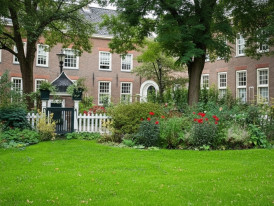
Peaceful Karthuizerhof courtyard with historic buildings
Quiet Jordaan Courtyards: My Secret Escapes
When city life gets overwhelming, which happens more often than I'd like to admit, I disappear into the Jordaan courtyards. Karthuizerhof is open daily from 10 AM to 8 PM, and stepping through that entrance feels like traveling back in time. Same with Hofje van Brienen, though they close earlier on weekends.
These aren't Instagram spots; they're actual functional spaces where people have lived for centuries. I've spent countless afternoons reading in these courtyards, especially during those long Dutch winters when you need to remember that beauty still exists.

Amsterdam Market
Markets Where Locals Shop
Ten Katemarkt runs Monday through Saturday, and it's where I do most of my grocery shopping. No tourist prices, no fake "authentic Amsterdam experience."
What you will see is Turkish and Moroccan vendors selling incredible produce alongside regulars who've been shopping here for decades.
Van der Pekmarkt in Noord feels like a village market that somehow survived being swallowed by the city. Wednesday, Friday, and Saturday mornings, 9 AM to 6 PM. I love the chaos of it.
Kids running around while parents argue over vegetable prices, elderly residents catching up on gossip. It's messy and real and everything I love about this city.
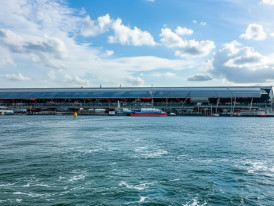
View from NDSM ferry
Free Ferry to NDSM: My Favorite Commute
Amsterdam's free ferries are hands down one of the best ways to see the city from the water. The F4 ferry to NDSM takes about 14 minutes, and I've taken it hundreds of times without getting bored of the view. The F7 is quicker (just 7 minutes), but I prefer the longer route when I'm not in a hurry.
These ferries run on the same public transport system as everything else, so if you've got a day to while away, you're golden. Did I mention they are free? I use them as a moving meditation when the city stress gets to me.
Neighborhood Guide: Where to Wander
Every Amsterdam neighborhood has its own personality. Understanding these areas gives you the full picture of how this city actually works beyond the tourist center.
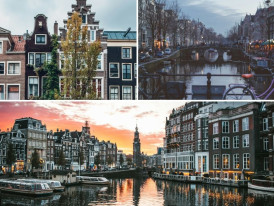
Different Amsterdam neighborhoods
Jordaan: Beyond the Postcard Bull
Everyone talks about the Jordaan like it's some preserved theme park, but the reality is messier and more interesting. Yeah, there are art galleries and cafés, but there are also normal people living normal lives between the tourist attractions.
Noordermarkt on Saturday mornings is where you'll find me buying organic vegetables and listening to street musicians who actually live in the neighborhood. The market has this energy that reminds me why I fell in love with Amsterdam in the first place.
De Pijp: Amsterdam's Most Lively Neighborhood
I lived in De Pijp for three years, and it taught me more about Amsterdam than any guidebook ever could.
Albert Cuyp Market runs Monday through Saturday, and it's where locals from every corner of the world come to buy groceries, argue about prices, and create the kind of beautiful chaos that makes this city special.
With that said, obviously, tourists have picked up on the awesomeness of this spot, so be warned: you won't be the only visitor soaking in the fun atmosphere.
Still, the food scene here is incredible. Not just the Dutch stuff, but Indonesian, Turkish, Moroccan, and everything else that reflects who actually lives in Amsterdam these days. This is where you eat if you want to understand the city beyond the tourist narrative.
This is More Than Just a Place on a List
Experience De Pijp through hidden corners and stories most visitors miss.
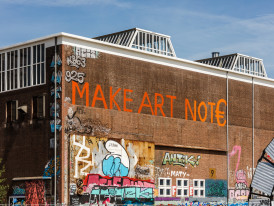
Modern creative spaces in Noord district
Oost and Noord: The Future of Amsterdam
Oost is where young families move when they can't afford the Jordaan anymore, and it's created this incredible creative energy.
Noord used to be industrial wasteland, but now it's where artists and designers are building the future of the city.
Café 't Sluisje has been serving Dutch food since 1904 in a building dating back to 1565, and somehow it's survived every wave of change Amsterdam has thrown at it. When I want to connect with the city's deep history while sitting in its most forward-thinking neighborhood, that's where I go.
Imagine Experiencing This Part of Amsterdam for Real
A local can show you the vibe, flavors, and hidden gems up close.
Oud-West: Multicultural Authenticity
Turkish and Moroccan vendors sell incredible produce alongside regulars who've been shopping here for decades. No hiked prices, no fake "authentic Amsterdam experience."
The neighborhood around the market has become Amsterdam's most authentic multicultural area, where third-generation Turkish-Dutch families run restaurants that serve both communities.
Westerpark: Culture Meets Green Space
Westerpark combines actual green space with cultural venues like Westergasfabriek in converted gas factory buildings. It's where locals with kids go for better picnic spots without the Vondelpark tourist density.
The park allows alcohol and barbecuing, making it perfect for afternoon gatherings when the weather cooperates. Bring blankets and snacks from local markets instead of buying expensive park café food.
Eastern Docklands: Modern Amsterdam on Water
For floating architecture, head to IJburg’s Waterbuurt or Schoonschip in Amsterdam-Noord. The Eastern Docklands shine for their Borneo-Sporenburg urban housing instead.
Lotti's in The Hoxton Hotel occupies a former prison turned cultural center, where the past and future collide in ways that shouldn't work but absolutely do.
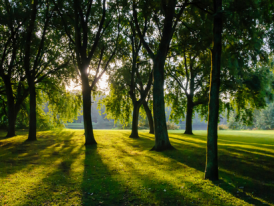
Rembrandtpark at sunrise
Nieuw-West: Real Amsterdam Families
Nieuw-West is where Amsterdam's working families actually live, in neighborhoods that don't make tourist guides but represent the majority of local life. Rembrandtpark provides better outdoor space than central parks.
This is Amsterdam without the performance, where grocery shopping and school pickups happen in multiple languages but feel completely normal.
Canal Belt Beyond Dam Square
Most tourists see the canal belt around Dam Square and think they've seen it all. But the real canal living happens further out, where houseboats aren't tourist attractions and canal-side terraces serve neighbors instead of tour groups.

Herengracht at sunset
Head down Herengracht when the sun has begun to set and locals are having drinks on their terraces. It's one of my favorite things to do, but unfortunately I don't get to go as often as I'd like to, so I recommend it to everyone I know.
Free evening entertainment that works year-round; even in winter, the lit windows and cozy indoor scenes create pure Amsterdam atmosphere.
Amsterdam's neighborhoods reward curiosity over guidebook compliance. Each tells a different part of the city's ongoing story.
Authentic Eats: Traditional Dutch Foods That Taste Amazing
Food culture represents some of the best things to do in Amsterdam for understanding both Dutch traditions and the international influences that make this city what it is today. Knowing what to eat in Amsterdam will make your visit even more amazing.

Traditional Dutch stroopwafels
Fresh Stroopwafels
The packaged tourist versions are cardboard compared to what you'll get at the Albert Cuyp Market stand, where they press them fresh and add the syrup filling while it's still warm enough to melt.
Noordermarkt on Saturday mornings also has a stand that does them right. The key is watching them get pressed; if it's not steaming when they hand it to you, walk away.
Perfect winter comfort food when you need something warm and sweet on cold Amsterdam days.
Herring Done Right
I was skeptical about herring until my neighbors basically forced me to try it properly. The cart at Nieuwmarkt has been there since the 1980s, and they know what they're doing.
Real Dutch herring is cured, not cooked, and when it's done right, it's this clean, salty burst of flavor that somehow makes perfect sense with onions and pickles. Locals eat them by holding the fish by its tail and taking bites, but using a fork works fine too.

Classic Dutch Bitterballen
Bitterballen Worth the Calories
Bitterballen are everywhere, but most places serve frozen garbage. Café Hoppe on Spui has been doing them right since 1670, and after trying theirs, every other version tastes like an insult to the concept.
The filling should taste like slow-cooked beef and herbs, not generic mush. Good bitterballen have a molten center that burns your tongue if you're impatient – that's how you know they're made fresh.
Pancakes and Poffertjes
Dutch pancakes are thin, crepe-like things you can actually fill with bacon and cheese for lunch. The Pancake Bakery near Anne Frank House does tourist versions, but locals go to smaller, lesser-known spots like Pat's Poffertjes in the Jordaan for the real deal.
Poffertjes are tiny puffy pancakes dusted with powdered sugar. Best eaten at winter markets when it's cold enough that the hot, sweet comfort actually makes sense.
Hungry to Try Amsterdam's Food Yourself?
Taste and explore the flavors locals actually love.

Traditional rijsttafel spread
Indonesian Rijsttafel
Restaurant Blauw serves an accessible rijsttafel that introduces Dutch-Indonesian fusion without overwhelming newcomers. Their modern take on traditional dishes reflects the complicated history between the Netherlands and Indonesia, but more importantly, it tastes incredible.
This elaborate spread of small dishes represents Amsterdam's most successful culinary import – spice levels accommodate Dutch palates, but the flavors stay complex and authentic.
Expect €35-45 per person for a full rijsttafel, but the variety and quality justify the price for this quintessential Amsterdam experience.
Surinamese Roti Sandwiches
Roopram Roti on Eerste van Swindenstraat makes roti with curry fillings that reflect Suriname's Indian, African, and Dutch influences layered into something uniquely Amsterdam.
These aren't tourist attractions – they're neighborhood spots serving Surinamese families who moved here decades ago and know what real comfort food should taste like.
Dutch Cheese Tasting
Skip the tourist cheese shops near major attractions and visit Reypenaer Cheese Tasting for education with your sampling. They actually explain why aged Gouda tastes different from young Gouda, and you can taste the difference.
Local markets like Albert Cuyp also have serious cheese vendors who'll let you sample before buying. That's where locals get cheese that doesn't cost more than your hotel room.
Indonesian Warungs for Casual Eats
For everyday Indonesian food that locals eat regularly, hit the places along Nieuwezijds Voorburgwal or in De Pijp. Warung Spang-Makandra serves dishes like rendang at neighborhood prices.
These aren't ethnic restaurants serving traditional dishes unchanged – they're Amsterdam restaurants run by Amsterdam families creating food that tells the city's real immigration story.
Offbeat Experiences: The Weird and Wonderful
The most memorable things to do in Amsterdam happen in places that make you go "wait, what?" These spots showcase the creative weirdness that makes this city special.

Micropia museum displays
Museums That Actually Surprise You
Micropia, right next to the main zoo entrance, is devoted entirely to microorganisms, and it's way cooler than it sounds. They've got these incredible high-tech displays that make bacteria and viruses look like abstract art.
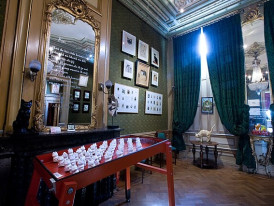
Quirky displays at the Cat Cabinet museum. Credit Jorge Royan
The Kattenkabinet (Cat Cabinet) is exactly what it sounds like: an entire museum dedicated to cat art housed in a 17th-century canal house. Works by Picasso, Rembrandt, and other masters feature cats. Plus, several actual cats wander around the galleries like they own the place, which, honestly, they probably do.
Cultural Experiences That Matter
Amsterdam's cultural scene goes way deeper than the big museums, offering countless ways to understand Dutch creativity and how this city thinks about itself.
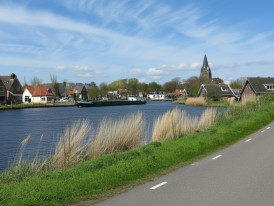
Scenic Amstel River cycling route with countryside
Museums That Actually Surprise You
Cycling Beyond the Tourist Routes
Amsterdam's bike infrastructure extends way beyond Vondelpark, and some of my favorite memories involve cycling routes that most visitors never discover.
The path along the Amstel River takes you through countryside that feels like a different century, and it's only 30 minutes from Dam Square.
Rent from neighborhood bike shops instead of the tourist companies near the station: better prices, better bikes, and they won't try to sell you a helmet like you're planning to ride through a war zone.
The route to Ouderkerk aan de Amstel follows the river through working farms and traditional windmills. There's a café at the end with river terraces that's perfect for the return journey, assuming you haven't gotten too distracted by how green and peaceful everything is.

Underground art venue performance
Underground Culture: Where Amsterdam Gets Weird
The underground scene exists in spaces that change constantly, which is part of the appeal. OT301 is housed in a former film academy building, and the experimental performances and art installations there remind you that Amsterdam is still a place where creative people can take risks.
RADION in Nieuw-West sits in the former Academic Center for Dentistry Amsterdam building where electronic music and digital art collide in ways that shouldn't work but absolutely do. Most shows start after 10 pm, which is perfect if you've spent the day doing tourist things and want to remember what Amsterdam feels like after dark.
Curious What You Won’t Find Online?
Discover the side only locals talk about.
Classical Music in Perfect Acoustics
The Concertgebouw has some of the best acoustics in the world, and I'm not just saying that because I live here. The building opened in 1888, and they got the sound right in ways that modern concert halls still can't match.
The free Wednesday lunchtime concerts at 12:30 pm are one of Amsterdam's best-kept secrets. Royal Concertgebouw Orchestra musicians performing in intimate settings with perfect acoustics? For free? I've been to dozens of these concerts, and they never get old.
They program jazz, world music, and contemporary stuff alongside classical, which keeps things from feeling stuffy. These represent some of the best cultural experiences in Amsterdam, especially if you think classical music isn't your thing.
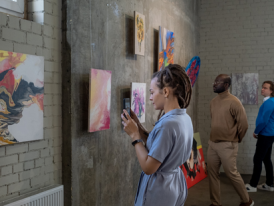
Contemporary warehouse gallery
Contemporary Art Beyond the Obvious
The gallery scene around Spiegelstraat near the Rijksmuseum showcases what Dutch and international artists are doing right now. Jaski Gallery regularly stages exhibitions and takes part in major art fairs.
Annet Gelink Gallery in the Jordaan focuses on international contemporary art in a converted warehouse space. Their video installations and conceptual work can be challenging, but it's the kind of challenging that stays with you.
Evening Culture: How Amsterdam Really Lives
Brown cafés after sunset become something different, gathering places where locals decompress from the day and engage in actual conversation. Café de Reiger in the Jordaan attracts artists, writers, and people who've lived in the neighborhood for decades.
The worn wooden furniture and dim lighting create an intimacy you can't manufacture.
De Twee Zwaantjes does weekend sing-alongs around the piano with traditional Dutch songs. I was skeptical until I experienced it. There's something about a room full of people singing together that transcends language barriers.

Leidsestraat
Music Venues That Give a Damn
Bourbon Street near Leidseplein is a proudly soulful place where you can enjoy jazz and blues, and even great drinks in an atmosphere that is so cozy it's almost from another world.
They've been operating since 1990, and many musicians who played there went on to amazing success, but they still book based on talent rather than fame.

Jazz performance at intimate venue
Jazz Café Alto is where serious musicians and knowledgeable audiences create the kind of musical conversations that bigger venues can't accommodate. It's intimate in the best possible way.
You feel like part of the performance rather than just observing it.
Day Trips: Escaping the City Bubble
The Netherlands' train system makes Amsterdam day trips ridiculously easy, and sometimes you need to get out of Amsterdam to appreciate what makes it special.
Haarlem is 20 minutes away and offers everything Amsterdam has with half the crowds.
The Frans Hals Museum and Saturday market provide authentic Dutch experiences where locals outnumber tourists. It's a great way to experience local charm without the Amsterdam intensity.

Haarlem market square from above
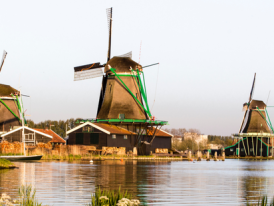
Zaanse Schans windmills
Utrecht, 30 minutes out, has these unique canal terraces and the 112-meter Dom Tower with panoramic views that make you understand how flat this country really is.
Zaanse Schans, 45 minutes away, showcases working windmills and traditional crafts. It's touristy but educational about pre-industrial Netherlands life.
Go Beyond the Amsterdam Checklist
Discover the parts of Utrecht guidebooks don’t cover with a local by your side.

Authentic Amsterdam nightlife scene
Nightlife: Beyond the Obvious
Amsterdam's best things to do in Amsterdam at night aren't in the places with street promoters and neon signs.
It happens in neighborhood areas where locals gather for conversations that last until closing time, and in small music venues like Café Central and Jazz Café Alto, where the music matters more than the marketing.
Avoid clubs with guys on the street trying to hand you flyers; they're tourist traps designed to separate drunk people from their money as efficiently as possible.
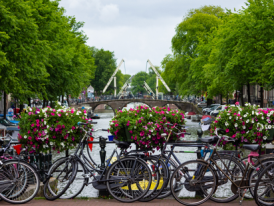
Traditional Amsterdam bikes parked along canal
Practical Stuff That Actually Helps
Bike rentals from neighborhood shops cost way less than tourist company rates and come with bikes that won't fall apart after three blocks. Public transportation uses OVpay contactless payment, which eliminates the need for separate transit cards.
Book popular museums ahead of time, especially the Anne Frank House, or you'll be disappointed. The city is compact enough that walking works for most central attractions, but cycling opens up Amsterdam neighborhoods that public transport doesn't serve efficiently.
Plan Smarter, Travel Better
Chat with someone who lives there and avoid wasting time on tourist traps.
Frequently Asked Questions
1) Do I need to book the Anne Frank House ahead of time?
Absolutely, and exactly six weeks ahead. Tickets go live every Tuesday at 10 AM CET and disappear fast. I've watched too many friends get shut out because they thought they could just show up. Set multiple alarms and have your payment info ready.
2) Is the Van Gogh Museum worth fighting the crowds?
Yes, but book early morning slots to minimize the chaos. The collection is comprehensive enough to justify the hassle, and the timed ticket system keeps things from getting completely overwhelming. Book ahead or risk disappointment.
3) What's the best canal cruise option?
Open boats that can navigate the smaller canals. The glass-topped tourist barges are fine for a basic overview, but you'll miss the intimate canal experience. Evening cruises showcasing illuminated buildings are particularly beautiful.
4) Which markets feel local instead of touristy?
Ten Katemarkt in Oud-West serves actual local communities: Turkish, Moroccan, and Dutch residents doing their weekly shopping. Van der Pekmarkt in Noord has a village atmosphere with local produce and second-hand goods. Both offer genuine experiences without tourist markup.
5) Are the free ferries actually free, and how do they work?
Yes, completely free. The F4 ferry to NDSM takes 14 minutes and offers excellent harbor views. The F7 takes 7 minutes. Both run frequently and use the same public transport card system as trams and buses.
6) How well does English work here?
About 90% of Amsterdam residents speak English fluently, and all major tourist information appears in English. Language barriers are rarely an issue for English-speaking visitors.
7) Airport to city center: how long really?
14-17 minutes by train with departures every 10-15 minutes during peak hours. Service runs all day with frequent departures. It's genuinely convenient.
8) Can I drink the tap water?
Yes, and it tastes better than most bottled water. Many cafés serve it free upon request, which saves money and reduces plastic waste.
9) Tipping culture: what's actually expected?
Tipping isn't mandatory. Locals often round up bills or leave 5-10% for exceptional service. Don't stress about it, service is included in prices.
10) Weather and timing: the truth
Amsterdam has an unpredictable maritime climate with possible rain any day of the year. Spring offers pleasant weather and tulips, but brings crowds. Summer provides long daylight but higher prices. Winter can be atmospheric with cozy café culture, despite short, gray days.
11) Getting around: what works best?
Bikes from neighborhood shops cost less and work better than tourist company rentals. Public transport uses simple contactless payment. Walking works great in the historic center, and cycling reaches areas that public transport serves inefficiently.
12) Can I visit the Jordaan courtyards?
Yes, but respectfully. Karthuizerhof opens daily 10 AM to 8 PM, Hofje van Brienen operates Mon-Fri 6 am-6 pm, Saturday 6 AM to 2 PM. These are working residential areas; keep quiet, no flash photography, and remember that people actually live there.

Sunset over Amsterdam's Canals
My Honest Take After Fifteen Years
The best things to do in Amsterdam reward curiosity over guidebook compliance. Yes, the Van Gogh Museum and Anne Frank House have earned their reputations through genuine quality, not marketing budgets.
But spend equal time in neighborhoods like De Pijp and Noord, where Amsterdam shows its working personality instead of its museum face.
Amsterdam's greatest strength isn't any single attraction but how seamlessly historic beauty integrates with contemporary life. This isn't a preserved theme park. It's a living city where people bike past 400-year-old buildings on their way to work, where traditional brown cafés exist alongside craft cocktail bars without anyone finding it weird.
The best Netherlands experiences that matter most aren't always Instagram-ready. This is something our City Unscripted hosts understand very well.
Sometimes amazing things happen in quiet Jordaan courtyards on a peaceful day or during random conversations with locals who genuinely want to share their city's stories.
Smart travelers discover that the most meaningful moments come from embracing Amsterdam's authentic character rather than chasing perfect photos. They know to enjoy the art and history of this great place as they stumble upon it.
Come with realistic expectations. Amsterdam is expensive, crowded, and often wet. (I like to think the public transportation system makes up for this!)
But it's also genuinely beautiful and culturally rich when you know where to look and what to skip. After fifteen years, I still discover new corners and fall in love with this impossible city all over again.
More Amsterdam Adventures
Ready to Plan Your Perfect Day in Amsterdam?
Start your experienceWhat If Exploring a City Felt More Personal?
City Unscripted pairs you with someone who lives there, so you can see iconic sights and hidden corners in a way that feels like yours.
Experiences Created by Locals, Just for You
See the city through the eyes of the people who call it home.
